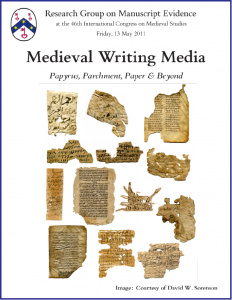David W. Sorenson
(Quincy, Massachusetts)
“Paper in Transition: The When, Where, and (Perhaps) Why of Paper in the Near East in the Late Middle Ages”
 Abstract of Paper presented at the 46th International Congress on Medieval Studies (Kalamazoo 2011)
Abstract of Paper presented at the 46th International Congress on Medieval Studies (Kalamazoo 2011)
Session on “Medieval Writing Media: Papyrus, Parchment, and Beyond”
Organized by Eleanor A. Congdon
2011 Congress Sessions
[First published on 1 September 2014]
One of the minor mysteries of late medieval book and document production in the Islamic world is the transition from home production exclusively to the use of imports exclusively around the Mediterranean (although much less so in Iran and India). This transition occurred entirely within the fifteenth century, primarily in the latter half, and can be studied through the examination of paper samples, given the lack (so far) of documentation in that part of the world.
The study of paper for the localization and dating of fragments and undated documents is particularly important given the paucity of any sort of commercial document from the period; with the exception of early (tenth- to eleventh-century) Egyptian material, and also the famous Cairo Genizah fragments, very little survives of this sort. Accordingly, every scrap must count. Even the “binder’s waste”, the used sheets which were pressed together to make binder’s board, employed in the Ottoman Empire, for example, is entirely or almost entirely omprised of old manuscript leaves rather than documents.
This presentation considers the background and the major types of Islamic paper; the introduction of Western paper; and the progress of replacement of local by Italian imported paper, along with some possible explanations for this replacement. It examines, in so far as possible at present, the local differences seen around the Near East, and as far east as Western India, and will propose ideas for further study.
*****
This is the first of the presentations by Dr. Sorenson in our annual series of sessions on “Medieval Writing Materials” at the 2011 Congress Sessions, 2012 Congress Sessions, 2013 Congress Sessions, and 2014 Congress Sessions. The Abstracts for the other presentations (so far) appear here: Sorenson (2012 Congress), Sorenson (2013 Congress), and Sorenson (2014 Congress).
